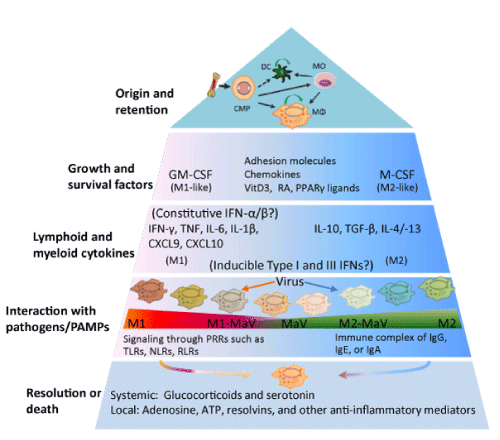
 |
| Figure 1: Incorporation of the antiviral state into a multilayer scheme of macrophage polarization. The top panel illustrates recent findings about the origin and self-renewal property of tissue macrophages. In contrast to the dichotomy system for addressing macrophage polarization that classifies macrophages either as classic (M1) or alternative (M2) activation statuses, a multipolar view has been proposed to revise macrophage polarization based on a much broader functional repertoire for macrophages mediated by various mediators/stimuli grouped in different layers [1,6]. Antiviral state (MaV), which is a cell-autonomous status to restrict virus infection and replication in response to viral infection or IFN stimulation, has not been well integrated into the paradigm of macrophage activation. In line with our previous work to study MaV in the framework of macrophage activation [70], here we elaborate the potential diversity of MaV states corresponding to the multifunctional properties of type I and type III IFNs as shown in Figure 2. CMP: Common Myeloid Progenitor; CXCL: Chemokine C-X-C Motif Ligand; DC: Dendritic Cells; (G)M-CSF: (Granulocyte-) Macrophage Colony-Stimulating Factor; MO: Monocyte; MΦ: Macrophage; NLR: NOD-Like Receptors; PPARγ: Peroxisome Proliferator-Activated Receptor gamma; PRR: Pathogen Recognition Receptor; RA: Retinoic Acid; RLR: RIG-Like Receptor; TLR: Toll-Like Receptor; VitD3: Vitamin D3. Modified from Martinez and Gordon [6]. |